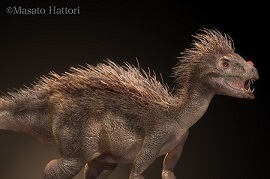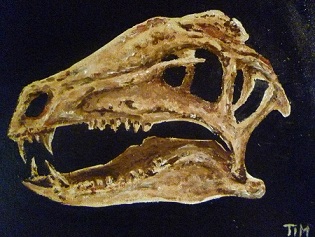
Pegomastax is a genus of small, herbivorous dinosaur that lived during the Early Jurassic period, around 200 million years ago. It belongs to the group of dinosaurs known as heterodontosaurids.
Pegomastax entered the scientific stage relatively recently, having been described in 2012. The name Pegomastax is derived from Greek words meaning strong jaw, alluding to its robust beak-like structure.
Pegomastax was a diminutive dinosaur, measuring only about two feet in length. Despite its small size, it provides valuable insights into the diversity of dinosaur body forms.
| Name: | Pegomastax dinosaurs |
| Size: | Around length:2 feet (60 cm);weight:2-5 kilograms (4.4-11 pounds). |
| Main Facts: | Pegomastax was a small, herbivorous dinosaur with unique quills, lived in the Early Jurassic period, South Africa. |
Pegomastax'smost distinctive feature was its beak-like mouth with sharp, fang-like teeth. This adaptation suggests a specialized diet and niche within its ecosystem.

Pegomastax was likely an herbivore, feeding on plants and vegetation. Its unique teeth suggest a potential for processing tough plant material.
Pegomastax inhabited the lush and diverse landscapes of the Early Jurassic. It lived alongside other small dinosaurs and early mammals, contributing to the complex food webs of its time.
Studying Pegomastax helps scientists understand the ecological interactions and adaptations of small dinosaurs in the Early Jurassic environment.
Comparisons between Pegomastax and other dinosaurs provide insights into the evolution and adaptations of small herbivores during the Jurassic period.
Due to its recent discovery, Pegomastax continues to be a subject of scientific inquiry, with researchers using advanced techniques to study its anatomy and behavior.
Pegomastax, a captivating figure from the Early Jurassic period, offers a glimpse into the world of prehistoric herbivores. Measuring around 2 feet in length, this small dinosaur, discovered in South Africa, presents a mosaic of intriguing traits. Its sharp teeth, resembling tusks, suggest an herbivorous diet that included plants, possibly fruits and vegetation.
What sets Pegomastax apart are the peculiar quills adorning its neck and back, reminiscent of modern-day porcupines. These quills likely served a defensive function, protecting Pegomastax from potential predators. Despite its relatively diminutive size, Pegomastax showcases the varied adaptations that dinosaurs developed to thrive in diverse ecosystems.
While much of Pegomastax's life remains a mystery due to its limited fossil record, its significance lies in its contribution to our understanding of the Early Jurassic's ecological complexity. This unassuming herbivore reminds us that the past is a tapestry of remarkable creatures, each offering a window into the rich history of life on Earth.
Pegomastax, an intriguing dinosaur from the Early Jurassic, offers captivating comparisons with other dinosaurs, unveiling insights into the diversity and adaptations of prehistoric life.
Pegomastax' diminutive size, about 2 feet in length, contrasts with larger dinosaurs like sauropods, showcasing the range of body forms in the Early Jurassic.
Pegomastax' beak-like structure distinguishes it from many dinosaurs, indicating herbivorous or omnivorous habits, similar to modern birds.
Pegomastax' bipedal stance aligns it with many theropods, differing from quadrupedal dinosaurs like sauropods, illustrating diverse locomotion strategies.
Fossil evidence places Pegomastax in Africa, similar to other early dinosaurs like Massospondylus, suggesting regional habitats.
Comparing Pegomastax' potentially spiky appearance to that of related dinosaurs reveals variations in body coverings and potential functions.
Pegomastax' specialized teeth for plant consumption set it apart from carnivorous dinosaurs like Coelophysis, showcasing diverse feeding strategies.
Pegomastax coexisted with other early dinosaurs, like prosauropods and small theropods, offering insights into interactions within the Early Jurassic ecosystem.